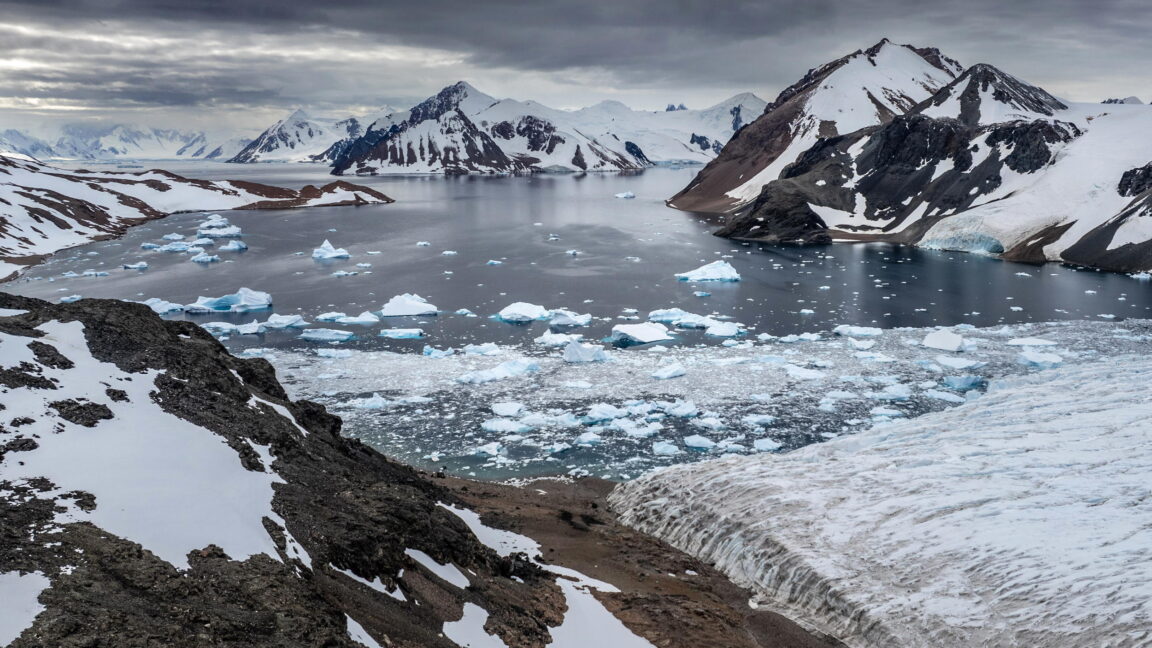Science
Antarctica Faces Greenland-Like Meltdown Amid Climate Crisis

Research indicates that Antarctica is experiencing significant changes similar to those seen in Greenland, raising alarms over the potential consequences for global sea levels. As recently as the 1990s, the vast ice cap of Antarctica appeared stable, while Greenland and the Arctic regions were already showing measurable thawing due to human-induced climate change. Recent studies, however, reveal that Antarctica’s ice caps, glaciers, and sea ice are increasingly vulnerable, suggesting a worrying trend toward a “Greenlandification” of the continent.
The Antarctic ice sheet, which spans approximately 5.4 million square miles—an area larger than Europe—contains over 61 percent of the world’s fresh water. If fully melted, it could raise global sea levels by about 190 feet. The smaller western region of this ice sheet poses an even greater threat, with potential to increase sea levels by more than 10 feet.
Ruth Mottram, an ice researcher with the Danish Meteorological Institute and lead author of a recent paper published in Nature Geoscience, emphasizes that the perception of Antarctica as a stable region is outdated. “We thought it was just going to take ages for any kind of climate impacts to be seen in Antarctica. And that’s really not true,” she stated. Mottram highlighted that early warnings emerged from observations of collapsing ice shelves and accelerated glacier movements.
One significant warning sign was the rapid collapse of the Larsen B ice shelf in 2002, located along the Antarctic Peninsula. After a series of record-warm summers created cracks and meltwater ponds, the ice shelf crumbled dramatically, leading to accelerated glacier movement toward the ocean. Geophysics professor Helen Amanda Fricker described the event as “a staggering occurrence” that occurred within weeks, a speed that surprised many scientists.
Fricker remarked that glaciologists traditionally viewed changes in Antarctica as gradual, spanning millennia. The collapse of the Larsen B shelf demonstrated that extreme warming could trigger rapid transformations. She likened the Antarctic Ice Sheet to a large reservoir held back by ice shelves, which are now deteriorating. “If humans had built those containment structures,” she noted, “we would think that they weren’t very adequate.”
According to NASA Earth Observatory data, the volume of ice entering the ocean from Antarctica has quadrupled since the 1990s, and researchers predict this trend could escalate significantly. The ice sheet is divided into three main sectors: the East Antarctic Ice Sheet, the West Antarctic Ice Sheet, and the Antarctic Peninsula, with the latter being particularly prone to melting.
Mottram’s research also points to a heatwave that struck the East Antarctic Ice Sheet in March 2022, driven by an atmospheric river—a concentrated stream of moisture-laden air. This event suggests that Antarctica is not as insulated from global climate changes as previously thought. She noted that research indicates an increase in the frequency and intensity of atmospheric rivers, which could further impact the region.
The Antarctic Ice Sheet is surrounded by a powerful circumpolar ocean current that has historically protected the Southern Ocean from warming. However, recent climate models suggest that this buffer is weakening, allowing warmer waters to reach the ice shelves’ bases. New data on regional wind patterns indicate that air from higher latitudes is increasingly influencing Antarctica’s climate.
Eric Rignot, an Earth system science professor at the University of California, Irvine, emphasized the interplay between ocean temperatures and ice shelf stability. He stated that while comparisons between Greenland and Antarctica are valuable, they remain complex due to differing rates of warming. Greenland is experiencing temperatures rising at two to three times the global average, which has led to significant changes in weather patterns in the Northern Hemisphere.
Mottram concluded her study with a call to action, urging greater awareness of the interconnectedness of global climate systems. “It’s not just this place far away that nobody goes to and nobody understands,” she said. “We actually understand quite a lot of what’s going on there. And so I also hope that it drives more urgency to decarbonize.”
The implications of these findings could be profound, as the melting of Antarctica not only raises sea levels but also alters global weather patterns, with potential ramifications for millions of people worldwide.
-

 Lifestyle2 months ago
Lifestyle2 months agoWinnipeg Celebrates Culinary Creativity During Le Burger Week 2025
-

 Health2 months ago
Health2 months agoMontreal’s Groupe Marcelle Leads Canadian Cosmetic Industry Growth
-

 Science2 months ago
Science2 months agoMicrosoft Confirms U.S. Law Overrules Canadian Data Sovereignty
-

 Education2 months ago
Education2 months agoRed River College Launches New Programs to Address Industry Needs
-

 Technology2 months ago
Technology2 months agoDragon Ball: Sparking! Zero Launching on Switch and Switch 2 This November
-

 Technology1 week ago
Technology1 week agoDiscord Faces Serious Security Breach Affecting Millions
-

 Science2 months ago
Science2 months agoTech Innovator Amandipp Singh Transforms Hiring for Disabled
-

 Technology2 months ago
Technology2 months agoGoogle Pixel 10 Pro Fold Specs Unveiled Ahead of Launch
-

 Science2 months ago
Science2 months agoChina’s Wukong Spacesuit Sets New Standard for AI in Space
-

 Technology2 months ago
Technology2 months agoWorld of Warcraft Players Buzz Over 19-Quest Bee Challenge
-

 Education2 months ago
Education2 months agoAlberta Teachers’ Strike: Potential Impacts on Students and Families
-

 Business2 months ago
Business2 months agoDawson City Residents Rally Around Buy Canadian Movement
-

 Technology1 week ago
Technology1 week agoHuawei MatePad 12X Redefines Tablet Experience for Professionals
-

 Business2 months ago
Business2 months agoNew Estimates Reveal ChatGPT-5 Energy Use Could Soar
-

 Science2 months ago
Science2 months agoXi Labs Innovates with New AI Operating System Set for 2025 Launch
-

 Technology2 months ago
Technology2 months agoInnovative 140W GaN Travel Adapter Combines Power and Convenience
-

 Technology2 months ago
Technology2 months agoFuture Entertainment Launches DDoD with Gameplay Trailer Showcase
-

 Technology2 months ago
Technology2 months agoGlobal Launch of Ragnarok M: Classic Set for September 3, 2025
-

 Technology2 months ago
Technology2 months agoNew IDR01 Smart Ring Offers Advanced Sports Tracking for $169
-

 Technology2 months ago
Technology2 months agoArsanesia Unveils Smith’s Chronicles with Steam Page and Trailer
-

 Science2 months ago
Science2 months agoNew Precision Approach to Treating Depression Tailors Care to Patients
-

 Business2 months ago
Business2 months agoBNA Brewing to Open New Bowling Alley in Downtown Penticton
-

 Technology2 months ago
Technology2 months agoHumanoid Robots Compete in Hilarious Debut Games in Beijing
-

 Health2 months ago
Health2 months agoGiant Boba and Unique Treats Take Center Stage at Ottawa’s Newest Bubble Tea Shop










